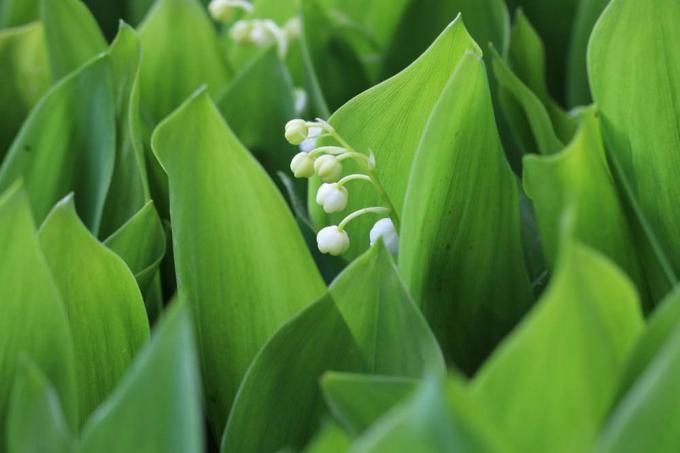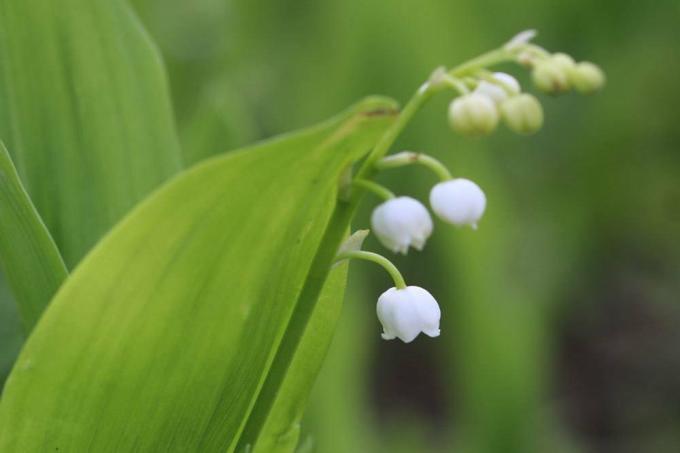
table of contents
- lily of the valley
- Toxicity
- Toxins
- Health risk
- For the people
- For pets
- For children
In spring they show beautiful white flowers that are reminiscent of the hood of a nun or maid: lilies of the valley (lat. Convallaria majalis). The plant comes from the asparagus family and is found in almost all of Europe. The plants grow mainly in beech and deciduous oak forests, but the plant can also be found on roadsides or even in gardens.
lily of the valley
As beautiful and fragrant as the little plants with their flowers and later with the red berries are unfortunately they are very poisonous and pose a serious health risk for humans and animals represent. More details on the occurrence and ingredients of the lily of the valley can be found in all common nature and plant guides.
Toxicity
Which parts of the plant are poisonous
All components of the lily of the valley are poisonous, from the stems and leaves to the roots to the flowers and berries. The toxins do not go away when the plant dries. Poisoning in connection with the plant can therefore occur relatively quickly. There is a risk that children in particular will ingest the poisons through their mouths by taking the flowers and later the Put red berries in your mouth, this includes touching them with your hands and their subsequent contact with the Mouth.
The only advantage of a possible poisoning with the constituents of the lily of the valley is that the body has a very low level of toxins Can absorb a lot and that children usually only want to taste a small part of the plants because they are simply curious about the taste are. This means that the amount of toxins absorbed is also low. As a result, poisoning remains unpleasant, but in most cases it comes off lightly.

Toxins
Which poisons the plants contain
Lilies of the valley contain cardenolide-type glycosides, which provoke a strong response from the heart. The highest concentration of glycosides is found in the flowers and seeds of the plant. This is exactly why the plant was popular as a remedy for heart problems in earlier centuries. The lily of the valley was previously called Salus Mundi, Heil der Welt, and for a while was even the professional emblem of doctors. Today there are again various drugs that contain a dose of plant components that the body can tolerate. Most medicines are given to treat heart problems such as abnormal heart rhythms. The recommended dose must be followed exactly.
Health risk
The health risks to humans
For the people
The first signs of poisoning by components of the lily of the valley can be nausea, vomiting and diarrhea. This is usually accompanied by dizziness or drowsiness, cramps in the gastrointestinal area and even visual disturbances. Depending on the severity of the poisoning and the physical constitution of the person concerned, cardiac insufficiency, a slow pulse and cardiac arrhythmias can occur. In particularly bad cases, after consuming parts of the lily of the valley, it can even lead to fatal poisoning.
Collecting wild garlic:
- Danger from confusing the leaves with those of the lily of the valley

By the way, there is a high risk of confusion when collecting wild garlic. Since the lily of the valley blooms at the same time as the autumn crocus and the wild garlic, the very similar looking leaves of these plants can be mixed up. In contrast to wild garlic, lilies of the valley and autumn crocus are poisonous. In case of doubt, the tuber should therefore also be dug up, as it can be used to determine exactly which of the three plants it is. It is also a good idea to visit a person who knows herbal before the supposed wild garlic is processed further. Experts are very familiar with the appearance of plants.
The right reaction when touched or consumed
If you come into contact with the poisonous lilies of the valley, it is by no means sufficient to just wash your hands and rinse your mouth with water. Regardless of whether it concerns children or adults, the emergency doctor must be called immediately. If necessary, the poison information center must be informed. Until the emergency doctor arrives, the vital functions of the body such as the pulse and breathing must be monitored continuously. If you have medical charcoal in your household, you can give it to the person affected as a first quick measure against poisoning. Further tips and hints are available from the Giftinformationszentrale Gizbonn.de or from the pharmacy Umschau.
For pets
What are the risks for animals such as cats and dogs
Just as it is dangerous for humans to come into contact with the components of the lily of the valley, this is also the case with pets such as dogs or cats. The plants are also poisonous to animals. Young animals in particular, with their pronounced instinct for play and discovery, like to sniff and taste everything that nature offers. It is therefore advisable to search the garden and the surrounding area for the plants and perhaps even move them to a safer place in good time.

If dogs or cats have eaten parts of the lily of the valley, the same symptoms can occur as in humans: diarrhea or vomiting, Nausea, dizziness and even convulsions are signs of poisoning and should be treated promptly by a veterinarian will. Cases of poisoning in pets must also be reported to the Poison Control Center. You can find more information about poisoning in animals at Snauz.de, the online magazine about animals.
For children
More tips for young parents
Many families today want a garden for the children as well as an opportunity to grow vegetables and fruit and thus fulfill their dream of gardening. Before gardening begins, the new environment should be scanned for poisonous plants. It is best to observe and get to know the garden all year round. Any poisonous plants such as the lily of the valley can thus be discovered in good time and, if necessary, dug up and moved to a safe place. So that there is no contact with the plant in the first place.



